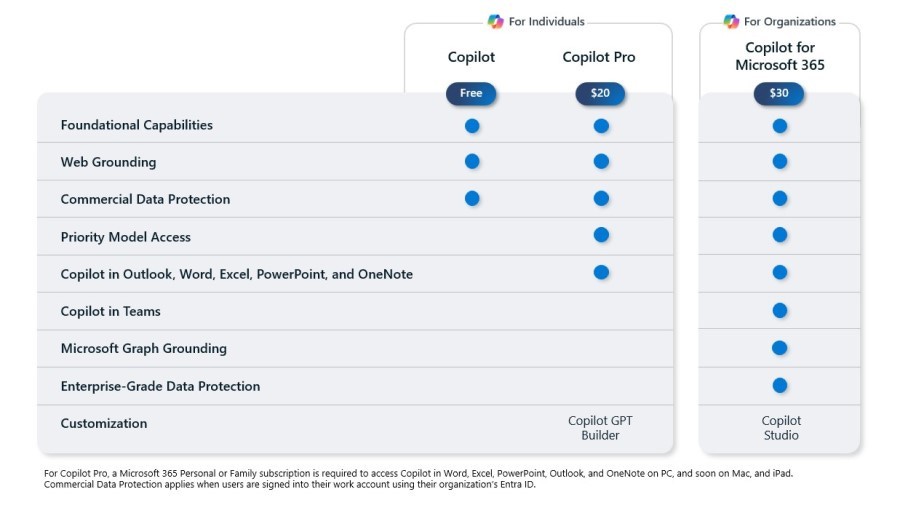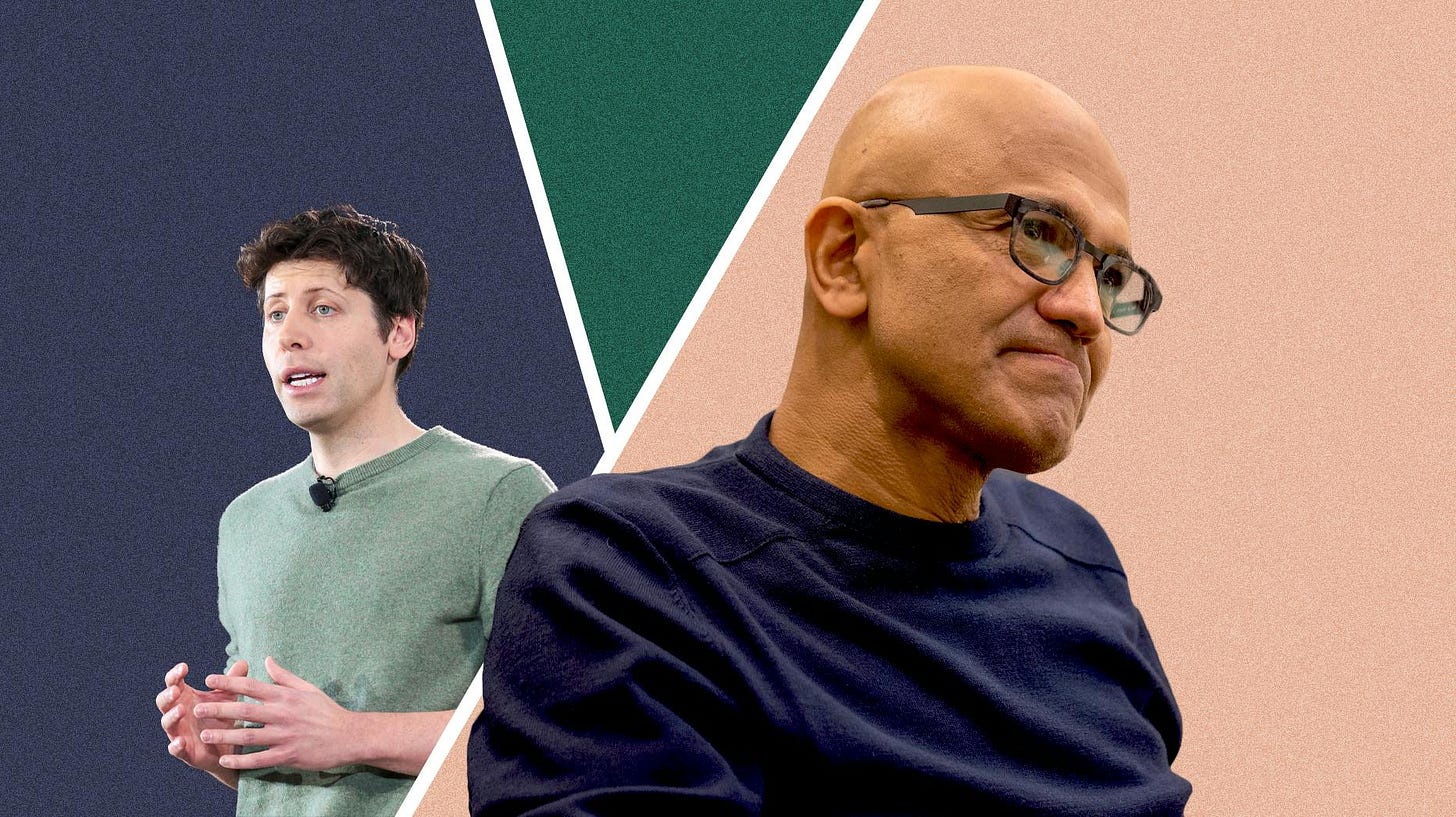AI: Microsoft's AI Puzzle and Pace
...going for the lead hard and fast, complete with backups
It’s likely one of the biggest, most complicated corporate partnerships, based on early and utterly uncertain technologies in decades. The long and dramatic path on how a multi-trillion dollar iconic technology company like Microsoft came to partner with OpenAI, a young startup with a novel governance history and structure, will likely be studied in business schools for years to come.
Yet January 2024 is almost over. And Microsoft is relentlessly focused on solving its opportunity puzzle with AI at a break-neck pace.
To switch metaphors, Microsoft continues to barrel down the snow and sleet filled slick AI highway at high speed. Under CEO Satya Nadella’s singular AI focus, the company seems to be layering AI onto all of its consumer and enterprise facing products and services. Most under the new brand face of Microsoft in 2024: Copilot.
In particular, there is now an AI Copilot for everything from Windows to Office, the two prior pillars of the Microsoft empire. Not to mention almost everything in between, like Github for coders, Edge for browsers, and of course Copilot Plus at $20+ per month. All available in a cornucopia of AI Bundles for anyone using Microsoft service across platforms and devices not just from Microsoft.
And it all comes in the familiar checkbox matrix of features in every version, we’ve seen for all Microsoft products for decades.
An aside for later, note that ‘Enterprise-Grade Data Protection’ feature only comes as an extra cost option. Not standard for all despite ubiquitous customer concern over the security and privacy of their data going into LLM AI models.
Regardless, it’s all available beyond ‘early invited testers’ in the wild, with various pricing options. Despite the ongoing GPU shortage from pivotal provider Nvidia, Microsoft has managed to deploy most of the above Copilots to most customers, premium or not.
The initial reviews are mixed, but trending to the positive in most cases. There continues to be a fair bit of patience for the various Copilots to get more reliable and useful. And a palpable enthusiasm for better AI utility to come from Microsoft’s ongoing latest and greatest.
And CEO Satya Nadella is not slowing down his vigorous leveraging of his multi-billion dollar partnership with OpenAI’s GPT-4 and ChatGPT foundation models and products. For now those products have been private labeled as Copilots, with Microsoft tweaks, mostly in the area of enterprise appealing features at scale. And most available via APIs that Microsoft can deploy faster than most other partners/customers of OpenAI.
But Satya Nadella is not counting on just OpenAI for the AI lifeblood of this almost $3 trillion market cap enterprise. He’s likely very aware that Mr. Market has added almost a trillion dollar of that market cap on AI enthusiasm alone. That of course following his key and core partnership with OpenAI years ago, and its turbocharging in November of 2022 with OpenAI’s ChatGPT debut.
And after the almost total upsetting of the Microsoft/OpenAI apple cart in November of 2023 with the Governance crisis at OpenAI, he’s also focused on having a backup plan. As he put it at the Davos WEF confab this week, Microsoft ‘needs to control its destiny’, meaning of course its AI destiny. As The Information noted recently:
“Microsoft’s push to put artificial intelligence into its software has hinged almost entirely on OpenAI, the startup Microsoft funded in exchange for the right to use its cutting-edge technology. But as the costs of running advanced AI models rise, Microsoft researchers and product teams are working on a plan B.”
“In recent weeks, Peter Lee, who oversees Microsoft’s 1,500 researchers, directed many of them to develop conversational AI that may not perform as well as OpenAI’s but that is smaller in size and costs far less to operate, according to a current employee and another person who recently left the company. Microsoft’s product teams are already working on incorporating some of that Microsoft-made AI software, powered by large language models, in existing products, such as a chatbot within Bing search that is similar to OpenAI’s ChatGPT, these people said.”
To that extent, the focus is on building backup alternatives for both the AI Large and Small Language models (LLMs and SLMs) going forward. Beyond OpenAI’s current and future products. This includes Microsoft’s fast-tracking of their SLM Phi-2 and related efforts. As Bloomberg described it, Mr. Nadella continues to balance Microsoft’s dependency on OpenAI and its founder/CEO Sam Altman:
“Nadella said his company, which received a non-voting board observer role following Altman’s return, isn’t pushing for a seat on the board. The software giant, which is OpenAI’s largest backer, has overhauled its entire product line around the technology that underlies ChatGPT, a product Nadella identified as the “first AI product that we all could relate to.”
“Yet, Nadella said Microsoft is not too dependent on OpenAI, noting that OpenAI relies on Microsoft for key parts of the technology it needs to create its products, and that Microsoft is also researching and developing its own AI programs apart from its partner.”
“I feel very good about the construct we have,” he said about the partnership. “I feel at the same time very capable of controlling our own destiny.”
Microsoft remains the singularly most focused of the ‘Magnificent 7’ companies on products and services leveraging the ongoing flow of exponentially better AI GPUs and hardware from partners like Nvidia, TSMC and others. The only other CEO with that wide and deep focus on the AI opportunity remains Jensen Huang of Nvidia, something I’ve discussed at length.
And Microsoft is building on their core capabilities in almost every box of the AI Tech Wave chart I’ve regularly discussed in these pages. (It’s now updated for 2024 to date).
Particularly from Boxes 2 to 6 above, from core infrastructure hardware, software and power-hungry data centers on up.
That’s not to say that the other major ‘Magnificent 7’ peers Google, Apple, Meta, Amazon, Nvidia and Tesla, not to mention OpenAI and others, are also not barreling down the snow and sleet laden AI Highway at various speeds as well. I’ve discussed their challenges and opportunities in previous posts and will continue to expoound on them as well in future posts.
But Microsoft under Satya Nadella is notable for its ‘All-in’ AI strategy at scale, across all their business fronts, with contigency backup plans to boot. I’ve long said the AI opportunity is early and a long set of marathon type races.
Microsoft is like the runner with the strategy take the lead and stay there summoning every bit of stamina possible. Impressive to watch. Stay tuned.
(NOTE: The discussions here are for information purposes only, and not meant as investment advice at any time. Thanks for joining us here)









